OntarioHunter
Well-known member
- Joined
- Sep 11, 2020
- Messages
- 5,980
Wrapping up one of these this morning and thought I'd pass along how I did it for those who might want to try.
After cleaning and drying the skull and jaw, I position the jaw open with a spacer between the front teeth and hold everything tightly together with plastic ties over the jaw socket joints and around the skull and jaw through orbits (eye sockets). I'll use a bit of hot glue in the jaw socket pivots to help hold everything in place while getting the plastic ties on.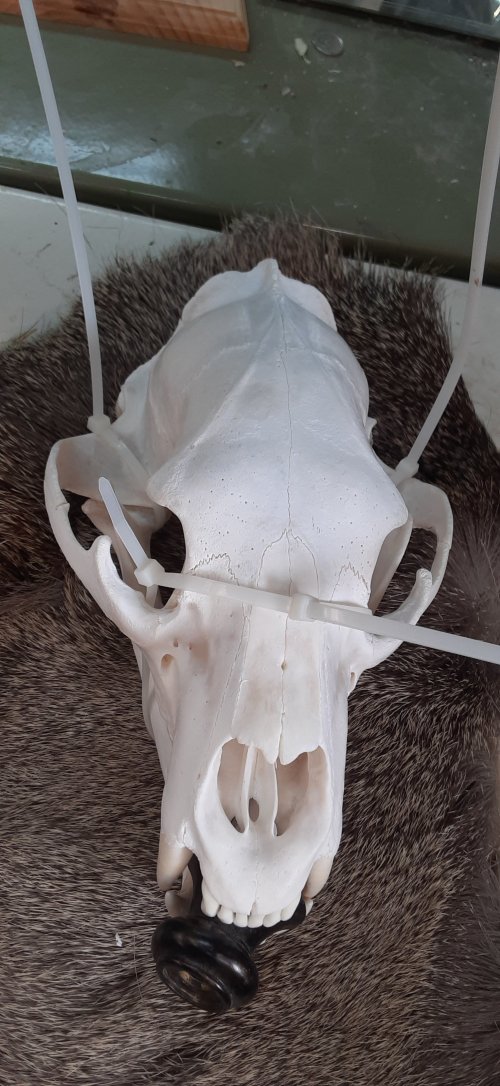
Then from underside drill two small holes through the jaw pivot joints and screw the joints together. I use #4×5/8" wood screws with just enough countersink to flush the screwheads.
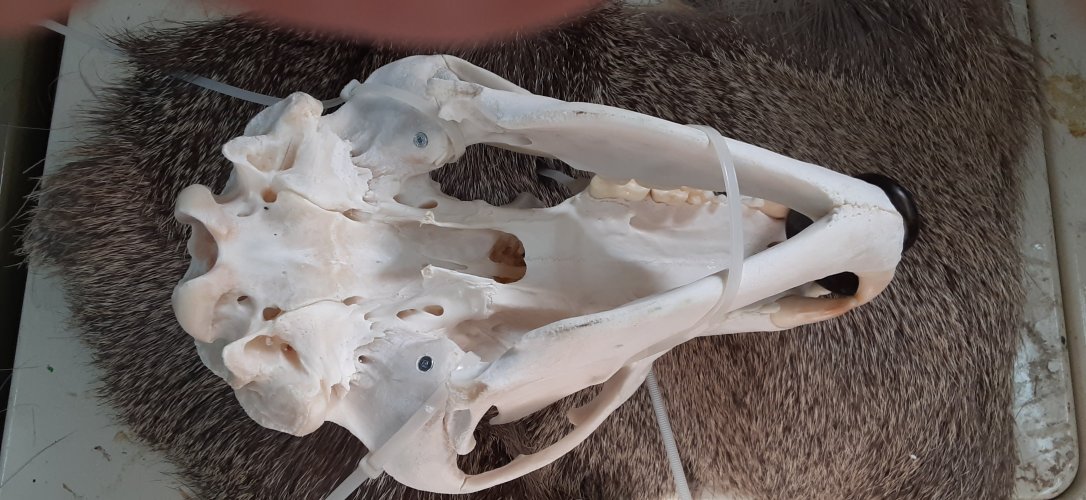
Then I mixed a small amount of epoxy and worked it into the cracks in jaw socket from underside. Let it set overnight and remove the plastic ties. The client wants this skull on a plaque with cartridge/casing and name/date plate. The plaque for this not very large bear was 8"×14", a bit overly long to accommodate the casing and name plate. Euro skulls for smaller animals are typically mounted with one screw through a specific spot just below the spinal cord canal (heavier skulls, particularly moose, require two screws and a backing plate). Drill the pilot hole exactly in the center of the bone if possible (the bone is crested in the center so this can be challenging). Use a very small drill for pilot and then open it up.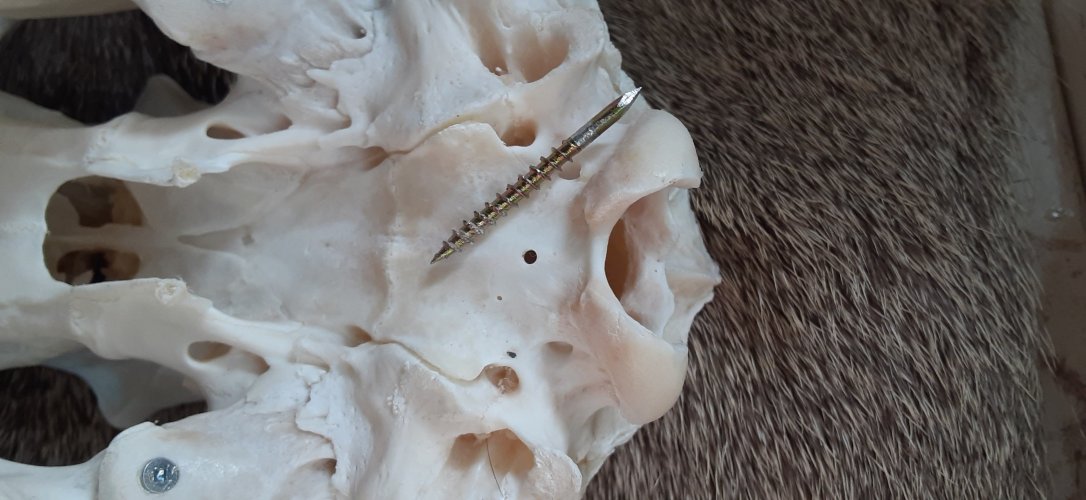 Thread on the screw size that will attach skull to plaque. I used a 2.5" construction screw. Then back it out and remove. Next, screw on the pilot marking screw using a pair of vice grips to hold it. To make a pilot marker, cut the head off a long screw and then file it to a point. Screw the marker down with vicegrip pliers till the point just touches workbench when skull is flipped over. Then position on the plaque so the skull is centered and push down so the marking screw point punches the plaque. NOTE: The marking screw should be attached VERTICAL to the angle of the jaw.
Thread on the screw size that will attach skull to plaque. I used a 2.5" construction screw. Then back it out and remove. Next, screw on the pilot marking screw using a pair of vice grips to hold it. To make a pilot marker, cut the head off a long screw and then file it to a point. Screw the marker down with vicegrip pliers till the point just touches workbench when skull is flipped over. Then position on the plaque so the skull is centered and push down so the marking screw point punches the plaque. NOTE: The marking screw should be attached VERTICAL to the angle of the jaw. 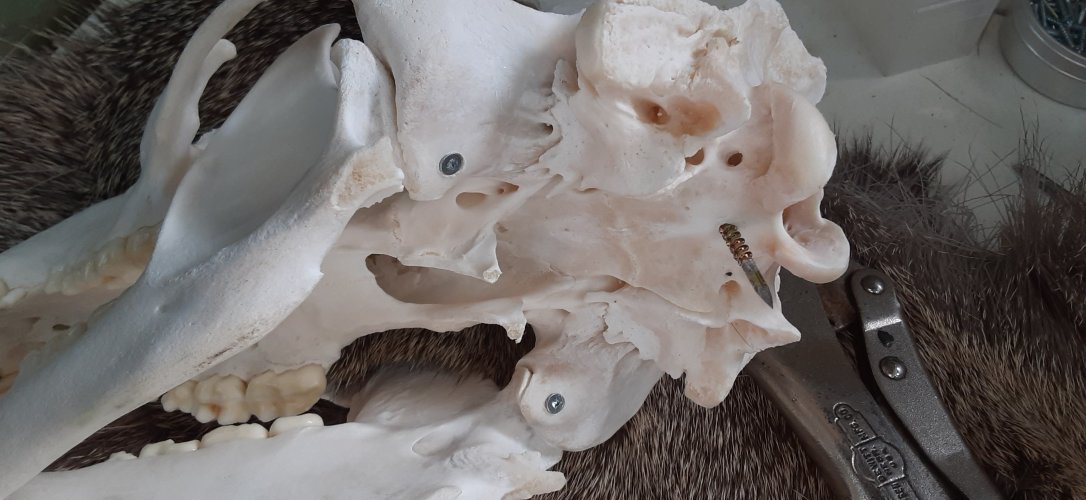
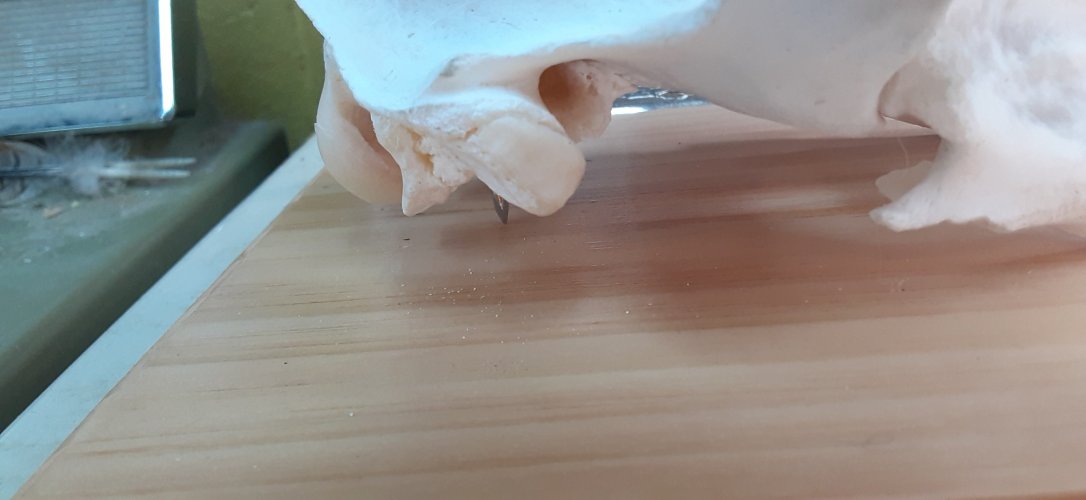 Once the plaque is marked, drill out the hanging screw hole through the plaque. Countersink the backside so the screw head does not protrude and mark wall paint when hung.
Once the plaque is marked, drill out the hanging screw hole through the plaque. Countersink the backside so the screw head does not protrude and mark wall paint when hung. 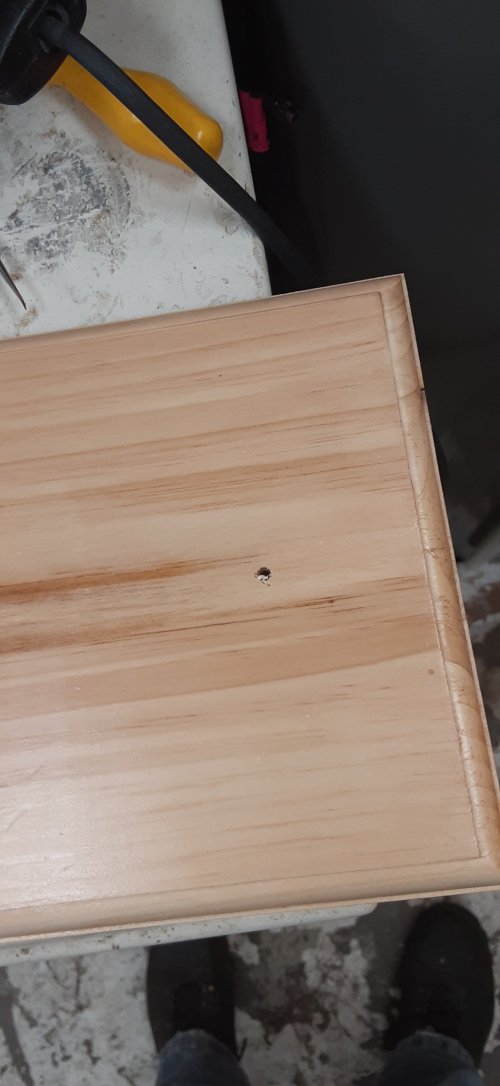
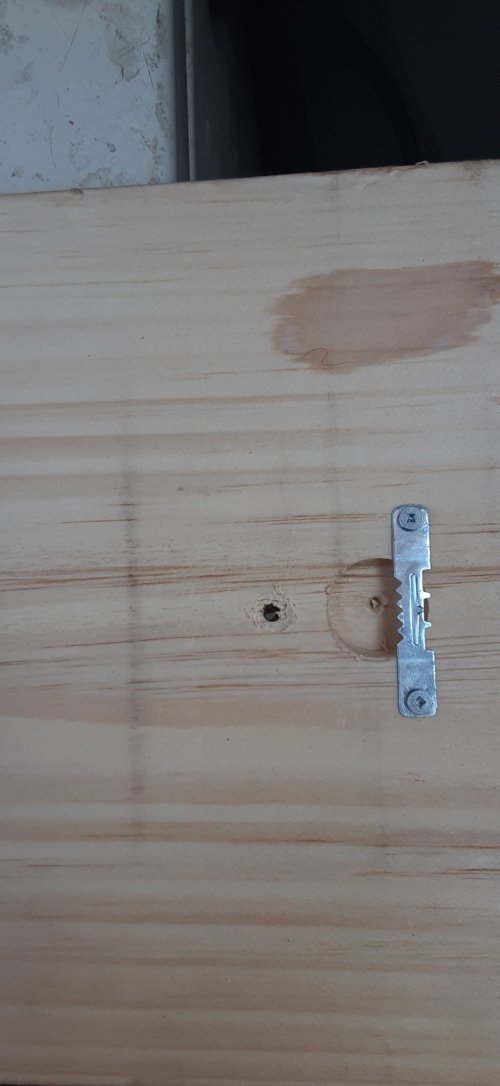 Note how I create my hangers. I use a forster bit to countersink a hole, flatten the cheap picture hanger, toss the brads that come with it, drill out holes in hanger, and attach with same size screws as above. The crappy brads will eventually pull out and trophy lands on the floor. Makes for unhappy clients! Countersinking allows the plaque to be hung flush to the wall. A little more work but makes for happy clients. I temporarily used one of my '06 casings and an old dog collar tag frame to center everything (client won't be in town with his casing for two weeks and trophy shops are closed during lockdown).
Note how I create my hangers. I use a forster bit to countersink a hole, flatten the cheap picture hanger, toss the brads that come with it, drill out holes in hanger, and attach with same size screws as above. The crappy brads will eventually pull out and trophy lands on the floor. Makes for unhappy clients! Countersinking allows the plaque to be hung flush to the wall. A little more work but makes for happy clients. I temporarily used one of my '06 casings and an old dog collar tag frame to center everything (client won't be in town with his casing for two weeks and trophy shops are closed during lockdown).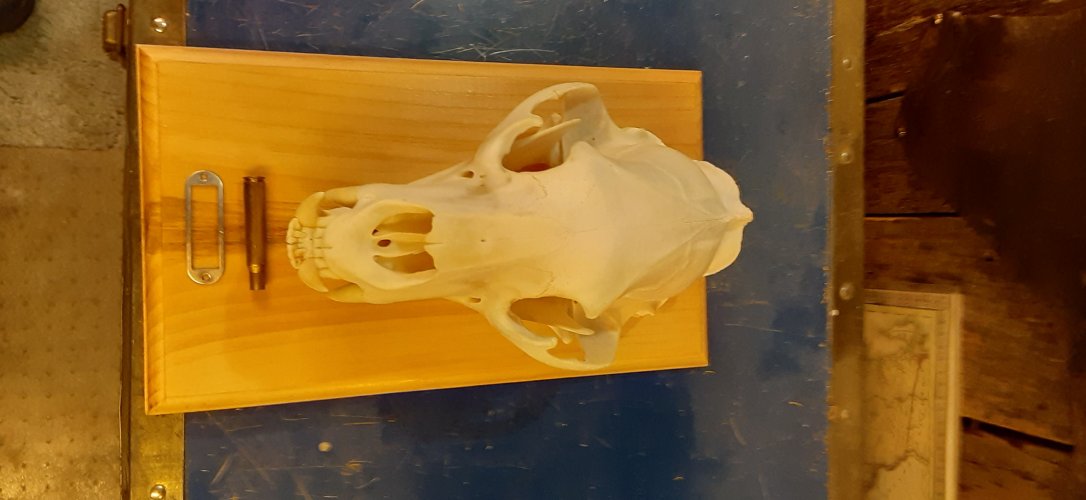
And now it's hanging awaiting those last two items.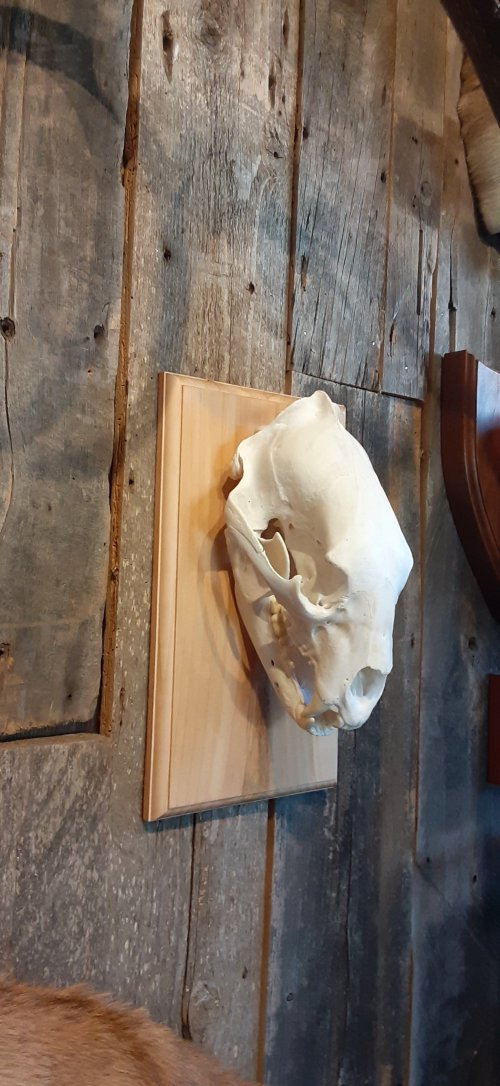 Ordinarily, without name plates, etc. I would make the plaque two inches wider and two inches longer than the skull (i.e. an inch on each side).
Ordinarily, without name plates, etc. I would make the plaque two inches wider and two inches longer than the skull (i.e. an inch on each side).
After cleaning and drying the skull and jaw, I position the jaw open with a spacer between the front teeth and hold everything tightly together with plastic ties over the jaw socket joints and around the skull and jaw through orbits (eye sockets). I'll use a bit of hot glue in the jaw socket pivots to help hold everything in place while getting the plastic ties on.

Then from underside drill two small holes through the jaw pivot joints and screw the joints together. I use #4×5/8" wood screws with just enough countersink to flush the screwheads.

Then I mixed a small amount of epoxy and worked it into the cracks in jaw socket from underside. Let it set overnight and remove the plastic ties. The client wants this skull on a plaque with cartridge/casing and name/date plate. The plaque for this not very large bear was 8"×14", a bit overly long to accommodate the casing and name plate. Euro skulls for smaller animals are typically mounted with one screw through a specific spot just below the spinal cord canal (heavier skulls, particularly moose, require two screws and a backing plate). Drill the pilot hole exactly in the center of the bone if possible (the bone is crested in the center so this can be challenging). Use a very small drill for pilot and then open it up.
 Thread on the screw size that will attach skull to plaque. I used a 2.5" construction screw. Then back it out and remove. Next, screw on the pilot marking screw using a pair of vice grips to hold it. To make a pilot marker, cut the head off a long screw and then file it to a point. Screw the marker down with vicegrip pliers till the point just touches workbench when skull is flipped over. Then position on the plaque so the skull is centered and push down so the marking screw point punches the plaque. NOTE: The marking screw should be attached VERTICAL to the angle of the jaw.
Thread on the screw size that will attach skull to plaque. I used a 2.5" construction screw. Then back it out and remove. Next, screw on the pilot marking screw using a pair of vice grips to hold it. To make a pilot marker, cut the head off a long screw and then file it to a point. Screw the marker down with vicegrip pliers till the point just touches workbench when skull is flipped over. Then position on the plaque so the skull is centered and push down so the marking screw point punches the plaque. NOTE: The marking screw should be attached VERTICAL to the angle of the jaw. 
 Once the plaque is marked, drill out the hanging screw hole through the plaque. Countersink the backside so the screw head does not protrude and mark wall paint when hung.
Once the plaque is marked, drill out the hanging screw hole through the plaque. Countersink the backside so the screw head does not protrude and mark wall paint when hung. 
 Note how I create my hangers. I use a forster bit to countersink a hole, flatten the cheap picture hanger, toss the brads that come with it, drill out holes in hanger, and attach with same size screws as above. The crappy brads will eventually pull out and trophy lands on the floor. Makes for unhappy clients! Countersinking allows the plaque to be hung flush to the wall. A little more work but makes for happy clients. I temporarily used one of my '06 casings and an old dog collar tag frame to center everything (client won't be in town with his casing for two weeks and trophy shops are closed during lockdown).
Note how I create my hangers. I use a forster bit to countersink a hole, flatten the cheap picture hanger, toss the brads that come with it, drill out holes in hanger, and attach with same size screws as above. The crappy brads will eventually pull out and trophy lands on the floor. Makes for unhappy clients! Countersinking allows the plaque to be hung flush to the wall. A little more work but makes for happy clients. I temporarily used one of my '06 casings and an old dog collar tag frame to center everything (client won't be in town with his casing for two weeks and trophy shops are closed during lockdown).
And now it's hanging awaiting those last two items.
 Ordinarily, without name plates, etc. I would make the plaque two inches wider and two inches longer than the skull (i.e. an inch on each side).
Ordinarily, without name plates, etc. I would make the plaque two inches wider and two inches longer than the skull (i.e. an inch on each side).



